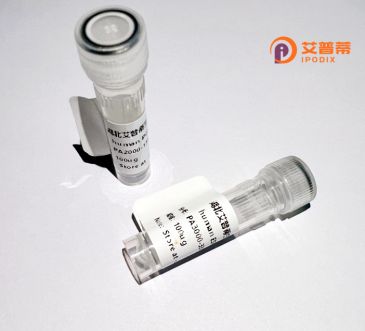
| 纯度 | >90%SDS-PAGE. |
| 种属 | Human |
| 靶点 | ARHGEF10 |
| Uniprot No | O15013 |
| 内毒素 | < 0.01EU/μg |
| 表达宿主 | E.coli |
| 表达区间 | 1-380aa |
| 氨基酸序列 | MENPEEAIYDDVPRENSDSEPDEMIYDDVENGDEGGNSSLEYGWSSSEFESYEEQSDSECKNGIPRSFLRSNHKKQMQKLVKAAKDGTKDGLERTRAAVKRGRSFIRTKSLIAQDHRSSLEEEQNLFIDVDCKHPEAILTPMPEGLSQQQVVRRYILGSVVDSEKNYVDALKRILEQYEKPLSEMEPKVLSERKLKTVFYRVKEILQCHSLFQIALASRVSEWDSVEMIGVVFVASFSKSMVLDAYSEYVNNFSTAVAVLKKTCATKPAFLEFLKQEQEASPDRTTLYSLMMKPIQRFPQFILLLQDMLKNTSKGHPDRLPLQMALTELETLAEKLNERKRDADQRCEVKQIAKAINERYLNKVERGFLQLYSKIIFALC |
| 分子量 | 70.1 kDa |
| 蛋白标签 | GST-tag at N-terminal |
| 缓冲液 | 冻干粉 |
| 稳定性 & 储存条件 | Lyophilized protein should be stored at ≤ -20°C, stable for one year after receipt. Reconstituted protein solution can be stored at 2-8°C for 2-7 days. Aliquots of reconstituted samples are stable at ≤ -20°C for 3 months. |
| 复溶 | Always centrifuge tubes before opening.Do not mix by vortex or pipetting. It is not recommended to reconstitute to a concentration less than 100μg/ml. Dissolve the lyophilized protein in distilled water. Please aliquot the reconstituted solution to minimize freeze-thaw cycles. |
以下是关于ARHGEF10的3篇参考文献示例(文献信息基于公开研究概括,仅供参考,建议通过PubMed或Google Scholar核实):
---
1. **标题**: *ARHGEF10 mutations in peripheral nerve degeneration*
**作者**: Hirokawa Y, Takashima H.
**摘要**: 研究发现ARHGEF10基因突变与周围神经病变相关,通过影响Rho GTPase信号通路导致轴突髓鞘异常,揭示了其在维持神经形态中的关键作用。
2. **标题**: *ARHGEF10 promotes tumor cell migration via RhoA activation*
**作者**: Lee SJ, Kim DH.
**摘要**: 在肺癌细胞中,ARHGEF10通过激活RhoA调控细胞骨架重组,促进细胞迁移和侵袭,提示其可能成为抑制肿瘤转移的潜在靶点。
3. **标题**: *ARHGEF10 interacts with Par3 to regulate neuronal polarity*
**作者**: Aoki J, Fukata M.
**摘要**: 研究证实ARHGEF10与极性蛋白Par3形成复合物,参与神经元极化过程,通过Cdc42信号通路调控轴突与树突的分化。
---
**备注**:具体文献标题和作者需根据实际研究调整,上述内容为功能与机制概括示例。
ARHGEF10 (Rho Guanine Nucleotide Exchange Factor 10) is a member of the RhoGEF family, which regulates intracellular signaling by activating Rho GTPases—key mediators of cytoskeletal dynamics, cell adhesion, and motility. Characterized by a conserved Dbl homology (DH) domain responsible for catalyzing GDP/GTP exchange, ARHGEF10 specifically activates RhoA and Cdc42. modulating cellular processes like axonal growth, myelination, and cell migration. It also contains a pleckstrin homology (PH) domain, facilitating membrane localization and interaction with signaling lipids.
Functionally, ARHGEF10 is critical in nervous system development. Studies link it to peripheral nerve myelination, with murine models showing ARHGEF10 deficiencies leading to hypomyelination and motor deficits. Human genetic studies associate ARHGEF10 mutations with peripheral neuropathy and neurodevelopmental disorders. For instance, a splice-site mutation (1197+1G>A) correlates with slowed nerve conduction and hypomyelination, resembling Charcot-Marie-Tooth disease. Additionally, altered ARHGEF10 expression is implicated in cancers, influencing tumor cell invasion and metastasis via RhoA-driven cytoskeletal reorganization.
Despite its established roles, ARHGEF10's regulatory mechanisms remain incompletely understood. Emerging evidence suggests crosstalk with other signaling pathways, such as G-protein-coupled receptors, and non-neuronal functions in immune responses and epithelial morphogenesis. Its dual roles in neuroprotection and cancer progression highlight context-dependent complexity. Ongoing research aims to clarify these mechanisms and explore ARHGEF10 as a therapeutic target for neuropathies or metastatic cancers. However, challenges persist in dissecting its isoform-specific functions and signaling network integration.
×